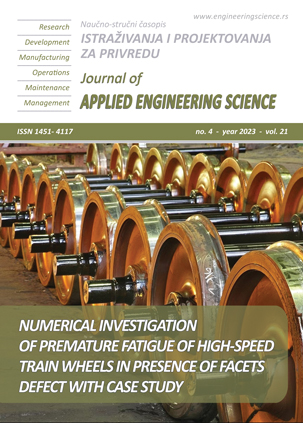MULTICRITERIA SELECTION OF A METHOD FOR PROCESSING MULTISPECTRAL EARTH REMOTE SENSING DATA
Abstract
The article is devoted to the use of qualimetry methods for models and polymodel complexes in order to solve one of the relevant engineering problems - automation of selecting methods for calculating Earth remote sensing (ERS) data processing when analysing the state of complex natural and technical systems. The proposed approach was discussed using the example of choosing methods for calculating forest sustainability indicators. A typical situation was considered when alternative methods and models can be applied at each stage of data processing. The essence of the proposed approach is to formulate and solve the task on multicriteria comparative analysis of processing methods based on a set of indicators, which include costs, required for implementation one or another method, efficiency, which refers to calculation duration of the analysed sustainability indicator, and an indicator reflecting the quality of the solution - accuracy of calculations result. The solution algorithm was illustrated within an example of choosing the method for assessing consequences of the forest fire. The selection results were presented in the form of a table, which allows the user to evaluate losses and gains in the values of partial indicators when moving from applying one method to another. The proposed algorithmization of the selection task determines possibility for its automation and, thereby, simplifying application of complex methods for processing ERS data for the end user. In addition, the possibilities and degree of validity for scaling the results of processing ERS data from individual areas to large forest areas are expanding.
References
Semek, F, et al. Airborne remote sensing. Theory and practice in assessment of terrestrial ecosystems. (2014). Global Change Research Centre AS CR, v.v.i., Brno.
Brovkina,O., Stojanović, M., Milanović, S., Latypov, I., Marković, N. & Cienciala, E. (2020). Monitoring of post-fire forest scars in Serbia based on satellite Sentinel-2 data. Geomatics, Natural Hazards and Risk, vol. 11, no. 01, 2315–2339, https://doi.org/10.1080/19475705.2020.1836037.
Anushree, B., Santosh, K. Panda, Dar, A. Roberts, Christine, F. Waigl, Uma, S. Bhatt, Christopher, W. Smith and Rand,i R. Jandt. (2021)/ Hyperspectral Data Simulation (Sentinel-2 to AVIRIS-NG) for Improved Wildfire Fuel Mapping, Boreal Alaska. Remote Sens, vol. 13(9), 1693, https://doi.org/10.3390/rs13091693.
Kourosh, Ahmadi, Bahareh, Kalantar, Vahideh, Saeidi, Elaheh, K. G. Harandi, Saeid Janizadeh and Naonori, Ueda. (2020). Comparison of Machine Learning Methods for Mapping the Stand Characteristics of Temperate Forests Using Multi-Spectral Sentinel-2 Data. Remote Sens, vol. 12(18), 3019, https://doi.org/10.3390/rs12183019.
Mochalov, V., Grigorieva, O., Zhukov, D., Markov, A., Saidov A. (2020). Remote Sensing Image Processing Based on Modified Fuzzy Algorithm. Silhavy, R. (eds) Artificial Intelligence and Bioinspired Computational Methods. CSOC 2020. Advances in Intelligent Systems and Computing, vol 1225. Springer, Cham. https://doi.org/10.1007/978-3-030-51971-1_46
Mochalov, V.F. (2020) Assessment of vegetation state based on modified fuzzy algorithm. Informatization and Communication, vol. 5, p.169-174. DOI: 10.34219/2078-8320-2020-11-5-169-174.
Poluektov, R. A., Pikh, Y. A., Shvitov, I. A. (1980). Dynamic models of ecological systems. Gidrometeoizdat, Leningrad.
Semevsky, F.N., Semenov, S.M. (1982). Mathematical Modeling of Ecological Processes. Gidrometeoizdat, Leningrad.
Khomyakov, P.M., Ivanov, V.D., Iskandaryan, R.A., et al. Geoecological modeling for environmental management purposes in condition of the change of natural environment and climate. USSR, Moscow.
Frelich, L.E. (2002). Forest Dynamics and Disturbance Regimes. Cambridge University Press, Cambridge.
Kuznetsov, V.I., Kozlov, N.I., Khomyakov, P.M. (2005). Mathematical modeling of forest evolution for forestry management. URSS, Moscow.
Rashka, S. (2017). Python and Machine Learning. Translation from English A.V. Logunova. DMK Press, Moscow.
Aurélien, Géron.(20190). Hands-On Machine Learning with Scikit-Learn, Keras, and TensorFlow. O'Reilly Media, Inc.
Terebizh, V. Yu. (2005). Introduction to statistical theory of inverse problems. Fizmatlit, Moscow.
Shovengerdt, R. A. (2010). Remote sensing. Methods and models of image processing. Tekhnosphere, Moscow.
Shestakova, T.A., Mackey, B.; Hugh, S., Dean, J., Kukavskaya, E.A., Laflamme, J.; Shvetsov, E.G., Rogers, B.M. (2022). Mapping Forest Stability within Major Biomes Using Canopy Indices Derived from MODIS Time Series. Remote Sens, vol.14, 3813. https://doi.org/ 10.3390/rs14153813.
Brovkina, O, Navr´atilov´a, B., Novotný, J., Luk´aˇs Slez´ak, J A., Cienciala, E. (2022). Influences of vegetation, model, and data parameters on forest aboveground biomass assessment using an area-based approach. Ecological Informatics, vol. 70, 101754, DOI: 10.1016/j.ecoinf.2022.101754..
Ghayour, L., Neshat, A., Paryani, S., Shahabi, H.; Shirzadi, A., Chen, W., Al-Ansari, N., Geertsema, M., Pourmehdi Amiri, M., Gholamnia, M. et al. (2021). Performance Evaluation of Sentinel-2 and Landsat 8 OLI Data for Land Cover/Use Classification Using a Comparison between Machine Learning Algorithms. Remote Sens. 2021, 13, 1349. https://doi.org/ 10.3390/rs13071349.
Mikoni, S.V., Sokolov, B.V., Yusupov, R.M. (2018). Qualimetry of Models and Polymodel Complexes. RAS, Moscow.
Petukhov, G.B. (1989). Fundamentals of the theory of task-oriented process effectiveness Pt. 1. Methodology, methods, models. MO SSSR, Moscow.
Mikhalevich, V. S., Volkovich, V. L. (1982). Computational methods for the study and design of complex systems. Nauka, Moscow.
You, H.; Gu, J.; Jing, W. (2023). Multi-Label Remote Sensing Image Land Cover Classification Based on a Multi-Dimensional Attention Mechanism. Remote Sens., vol.15, 4979. https://doi.org/10.3390/rs15204979.
Yuting, Wan, Chao, Chen, Ailong, Ma, Liangpei, Zhang, Xunqiang, Gong, Yanfei, Zhong. (2023). Adaptive Multistrategy Particle Swarm Optimization for Hyperspectral Remote Sensing Image Band Selection. IEEE Transactions on Geoscience and Remote Sensing, vol.61, 1-15, doi: 10.1109/TGRS.2023.3305545.
Ayna, C.O.; Mdrafi, R.; Du, Q.; Gurbuz, A.C. (2023). Learning-Based Optimization of Hyperspectral Band Selection for Classification. Remote Sens., vol. 15, 4460, https://doi.org/10.3390/rs15184460.

